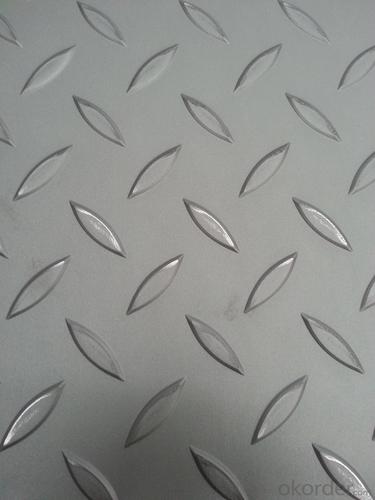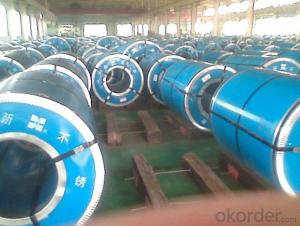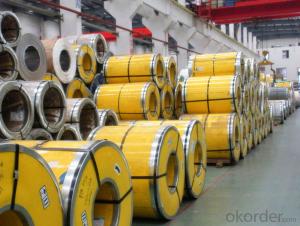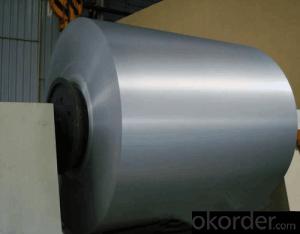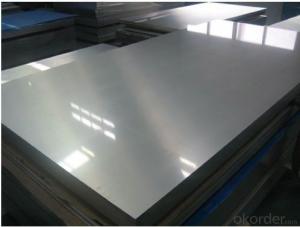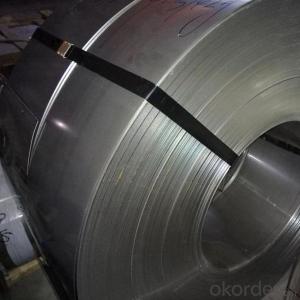304 2B diamond plate sheets stainless steel
- Loading Port:
- Shanghai
- Payment Terms:
- TT OR LC
- Min Order Qty:
- 50 m.t.
- Supply Capability:
- 10000 m.t./month
OKorder Service Pledge
OKorder Financial Service
You Might Also Like
Stainless Checker Plate 2B Finish diamond plate sheets stainless steel
Item | Checker Plate, Diamond Plate, Stamped Plate Stainless |
| Material | 201.202. 304. 304l.316/316l, 310/310s/ 309s, 410.420.430 ,2205. |
Thick | 0.5mm - 100mm |
Wide | 1M, 1.22M, 1.5M, |
Long | 2M, 2.44M, 3M, 6M |
Technic | Cold Rolled, Hot Rolled |
Surface | 2B, BA, NO.4, Hairline, No.1, 8K (mirror) |
Standard | AISI, ASTM, DIN, EN, GB, JIS |
MOQ | 500 KGS |
Payment Term | TT, L/C at sight. |
Delivery Time | 30 days |
Delivery Term | FOB, CIF, CNF. |
Loading Port | Shanghai |
Packing Method | Each with PVC protective film , Packed with durable paper |
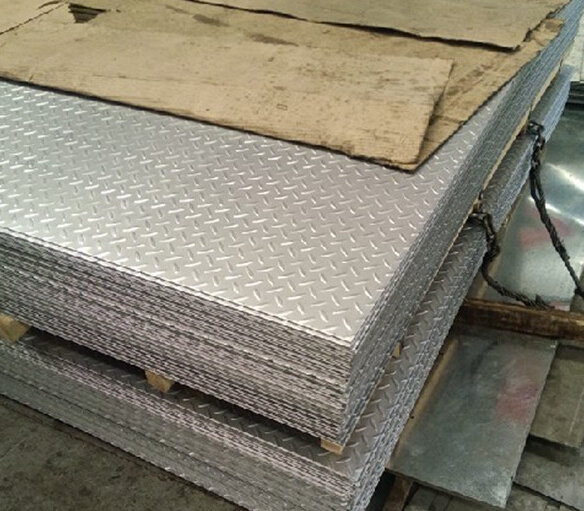
Chemical Composition
C | Si | Mn | Cr | Ni | S | P | Mo | |
304 | ≤0.08 | ≤0.075 | ≤2.0 | 18.0--20.0 | 8.0--11.0 | ≤ 0.03 | ≤0.04 | ----- |
- Q: What are the applications of 111 stainless steel strips?
- 111 stainless steel strips have a multitude of uses across a range of industries. One major application is in the automotive sector, where they are utilized for manufacturing components like exhaust systems, fuel tanks, and structural parts. The superior corrosion resistance and high strength properties of 111 stainless steel make it an ideal material for these purposes, ensuring longevity and durability. Another area where 111 stainless steel strips are commonly employed is in the construction industry. They are frequently used for cladding, roofing, and flashing due to their exceptional resistance to corrosion, weathering, and fire. These strips act as a protective barrier against harsh environmental conditions, guaranteeing the durability of buildings and structures. Furthermore, 111 stainless steel strips find usage in the production of kitchenware and appliances. Their ability to resist staining and corrosion makes them a suitable choice for manufacturing sinks, countertops, and other kitchen equipment. Additionally, they are utilized in the manufacturing of household appliances such as refrigerators, dishwashers, and ovens, where durability and hygienic properties are of utmost importance. In the medical field, 111 stainless steel strips are integral to the production of surgical instruments, implants, and medical devices. The biocompatibility and corrosion resistance of this material are crucial for ensuring the safety and long-term performance of medical equipment. Moreover, 111 stainless steel strips are employed in the energy sector, particularly in the production and transportation of oil and gas. They are commonly used in pipelines, storage tanks, and offshore platforms due to their exceptional strength, corrosion resistance, and ability to withstand extreme temperatures and pressures. Overall, the applications of 111 stainless steel strips are extensive and encompass the automotive, construction, kitchenware, medical, and energy industries. The unique combination of properties offered by this material makes it a favored choice for various applications where strength, corrosion resistance, and durability are essential.
- Q: Can stainless steel strips be used in jewelry making?
- Yes, stainless steel strips can be used in jewelry making. Stainless steel is a durable and corrosion-resistant material, making it an excellent choice for creating long-lasting and high-quality jewelry pieces. Stainless steel strips can be easily shaped, cut, and polished to create various jewelry components such as earrings, bracelets, necklaces, and rings. Additionally, stainless steel is hypoallergenic, making it suitable for individuals with sensitive skin or metal allergies. It also offers a sleek and modern look, making it a popular choice for contemporary jewelry designs.
- Q: Can stainless steel strips be used for heat exchanger plates?
- Yes, stainless steel strips can be used for heat exchanger plates. Stainless steel is a highly durable and corrosion-resistant material, making it suitable for use in heat exchangers. The strips can be easily formed into plates of various shapes and sizes, providing flexibility in design and installation. Additionally, stainless steel has excellent thermal conductivity, ensuring efficient heat transfer between fluids. Overall, stainless steel strips are a popular choice for heat exchanger plates due to their strength, resistance to corrosion, and thermal conductivity properties.
- Q: Can stainless steel strips be used in defense applications?
- Indeed, defense applications can make use of stainless steel strips. Renowned for its strength, durability, and resistance to corrosion, stainless steel proves to be an ideal material for various defense-related purposes. Its exceptional qualities enable the manufacturing of military vehicle components, including armor plating, brackets, and reinforcements, as it can endure high impact and provide protection against ballistic threats. In addition, stainless steel strips find utility in fabricating weapon systems, ammunition, and equipment employed by defense forces. The material's ability to resist heat and corrosion renders it suitable for applications such as missile casings and jet engine components. Consequently, stainless steel strips are extensively employed in defense applications due to their superior mechanical properties and reliability.
- Q: How do stainless steel strips compare to other materials?
- Stainless steel strips have several advantages that make them stand out when compared to other materials. Firstly, stainless steel is known for its exceptional corrosion resistance. This makes it ideal for various applications where the material will be exposed to moisture, chemicals, or harsh environments. Unlike other materials, stainless steel does not rust or stain easily, ensuring durability and longevity. Secondly, stainless steel strips offer excellent strength and toughness. They have a high tensile strength, which means they can withstand heavy loads and resist deformation under stress. This makes stainless steel strips suitable for applications that require structural integrity and reliability. Another significant advantage of stainless steel strips is their aesthetic appeal. Stainless steel has a sleek and modern appearance that can enhance the visual appeal of any project or product. It is often used in architecture and interior design for its clean and contemporary look. Furthermore, stainless steel strips are highly versatile. They can be easily formed, welded, and fabricated into various shapes and sizes to meet specific requirements. This flexibility allows stainless steel strips to be used in a wide range of industries, including construction, automotive, aerospace, and manufacturing. Lastly, stainless steel is a sustainable and environmentally friendly material. It is 100% recyclable, making it an excellent choice for projects with a focus on sustainability. Additionally, stainless steel has a long lifespan, reducing the need for frequent replacements and minimizing waste. Overall, stainless steel strips offer superior corrosion resistance, strength, aesthetic appeal, versatility, and sustainability when compared to other materials. These characteristics make stainless steel an excellent choice for numerous applications in various industries.
- Q: Can stainless steel strips be used in the production of HVAC ducts?
- Indeed, HVAC ducts can utilize stainless steel strips. The durability, resistance to corrosion, and ability to endure high temperatures make stainless steel a favored option for HVAC ductwork. In the construction of the ducts, stainless steel strips are frequently employed as they can be conveniently sliced, bent, and molded into the desired configuration. Moreover, stainless steel ensures a sanitary and hygienic atmosphere for the air flowing through the ducts, rendering it appropriate for a range of uses in residential, commercial, and industrial domains.
- Q: Are stainless steel strips suitable for pressure piping?
- Yes, stainless steel strips are suitable for pressure piping. Stainless steel is known for its excellent corrosion resistance, high strength, and durability, making it a preferred material for various applications, including pressure piping. Stainless steel strips can withstand high pressure and temperature conditions, making them suitable for use in industries such as oil and gas, chemical processing, and power generation. Additionally, stainless steel strips offer superior resistance to both internal and external corrosion, ensuring the integrity and longevity of the pressure piping system.
- Q: Can stainless steel strips be used in water treatment plants?
- Indeed, water treatment plants can utilize stainless steel strips. Stainless steel, known for its exceptional resistance to corrosion, proves to be a suitable material for enduring the challenging conditions prevalent in water treatment facilities. It finds extensive usage in a wide range of components including pipes, tanks, valves, and fittings. The ability of stainless steel to resist corrosion, chemical assaults, and elevated temperatures renders it an optimal selection for water treatment purposes. Furthermore, the smooth and non-porous surface of stainless steel prevents the proliferation of bacteria and biofilm, thereby guaranteeing the impeccable quality and purity of the treated water.
- Q: Can stainless steel strips be used in chemical reactors?
- Yes, stainless steel strips can be used in chemical reactors. Stainless steel is widely used in chemical industries due to its excellent corrosion resistance properties. It is resistant to various chemicals, including acids, bases, and organic solvents, making it suitable for use in chemical reactors. Stainless steel strips can be fabricated into various shapes and sizes to meet the specific requirements of a chemical reactor. Additionally, stainless steel's high strength and durability make it ideal for withstanding the harsh conditions and pressures often encountered in chemical processes.
- Q: Are stainless steel strips heat resistant?
- Yes, stainless steel strips are heat resistant. Stainless steel is known for its ability to withstand high temperatures without deformation or damage. It has a high melting point and can retain its strength even at elevated temperatures. This makes stainless steel strips suitable for various applications that involve exposure to heat, such as in industrial processes, cooking utensils, and automotive components. Stainless steel's heat resistance also contributes to its durability and longevity, as it can withstand thermal stress and maintain its structural integrity over time.
Send your message to us
304 2B diamond plate sheets stainless steel
- Loading Port:
- Shanghai
- Payment Terms:
- TT OR LC
- Min Order Qty:
- 50 m.t.
- Supply Capability:
- 10000 m.t./month
OKorder Service Pledge
OKorder Financial Service
Similar products
Hot products
Hot Searches
Related keywords




